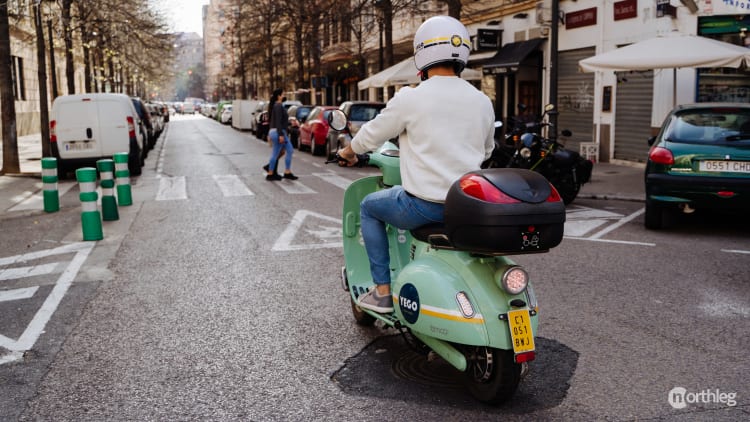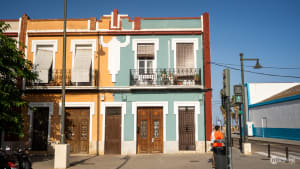
How to Get Around Valencia
Valencia is the third biggest city in Spain, and it is well worth visiting every corner. To be able to see it all, choose the means of transportation that works best for you.
How to get around Valencia in a nutshell...
Valencia offers a variety of transportation options to suit every traveler’s needs. The city’s excellent public transit system includes six metro lines and four tram lines that efficiently connect major attractions, complemented by an extensive bus network (red EMT buses within the city, yellow MetroBus for suburbs and airport).
For ticket options, the SUMA pass provides the best value for public transportation, allowing travel across buses, metro, and trams. The Valencia Tourist Card is ideal for visitors, offering unlimited public transport plus museum discounts.
Those seeking flexibility can choose between Valenbisi (the public bike-sharing system with 275 stations throughout the city), taxis (easily hailed on streets or booked through apps like Free Now), or electric scooter rentals from providers like Cooltra, Yego, and Acciona.
Valencia’s compact size, flat terrain, and pleasant climate also make it perfect for exploring on foot, particularly in the historic center where you can discover hidden corners and charming alleyways at your own pace.
Most likely, you will end up using a combination of the many options to move around the city, from public to private transportation. The metro and public buses certainly offer frequent and complete service.
For public transport use, the city is divided into three concentric areas (zonas in Spanish) and one overlap area. The majority of tickets and passes come in different zone-coverage options.
Here you have an explanation of the different areas so that you can make the best choice with regards to your transport ticket.
- Zone A is the biggest and most central one. It covers the city with its most important sightseeing spots, the old centre, the newer and trendy neighbourhoods, as well as the beach. The tram service runs mainly in this area. You will most likely be moving around zone A on your visit.
- Zone A-B is the overlap area. Its function is to keep prices low for those that travel between bordering zones. People moving from these areas to the nearby zones A or B (and vice versa) will be able to get single-zone tickets. The municipalities belonging to this area are those belonging to l’Horta - the larger urban area of Valencia.
- Zone B is the area directly around A. It covers mostly small towns and municipalities belonging to the metropolitan areas of Camp de Turia (northeast of the city), Camp de Morvedre (north of the city), and Ribera (south of the city).
- Zone C is equivalent to the airport. It serves the purpose of separating the airport from all other areas.

If rather than relying on public transportation, you want to invest in comfort, you can always take a taxi. Or you might even want to try out the ever more popular stand-up e-scooters, zooming through traffic in the city.
If instead, you want to be active, you can take a stroll on a bike or even walk, enjoying the greenery in the sunny city of Valencia.
Metro and Tram
There are a total of six metro lines and four tram lines in Valencia, covering the city’s urban area and its surroundings pretty well.
Normally, in underground metro stations, you will find turnstile gates at entrance and exit points. You will need to tap your ticket or transport card on the red circle in order to open the swinging barriers and access the platforms. You will also need to tap on your way out with the same ticket.

However, in some above-ground stations (often located in the outskirts of the city), you will find free access to the platforms. This doesn’t mean you don’t have to tap your card. You must tap your card on the column-like access control devices.
The system is the same, you tap your card on the red circle and after the sound your card is registered. If you don’t do this and metro security checks your card, they will fine you.

The metro and tram services are great if you need to reach your destination quickly, avoiding congested traffic. The trains are frequent and reliable: there is a train available once every few minutes, depending on the line. However, if you don’t have a specific plan or just want to take the city in as you are going, the metro might not be your best option.
Most stations are fully accessible for people with reduced mobility, with a small gap between train and platform. Companions of wheelchair users should be eligible for free travel. For more info about accessibility in Valencia’s metro stations, have a look at the MetroValencia website .
If you want more information about this service, have a look at our article about the metro and tram in Valencia.
Tickets
Public transportation passes or tickets can be purchased in many different places. If you want more in-depth information, you can check out this article about available tickets and where to get them.
However, if you are using the metro, the simplest way to get a ticket is directly at a metro station. You can do so either at an automated machine or with the help of a clerk at a stand.
All automated machines will have a selection of languages to choose from, including English. You will have many options: single tickets, 10-journey tickets, transportation passes for a number of days (and passengers). You will also be able to choose the areas that you want to cover.

Remember that any multiple-journey SUMA pass will be also valid for other transportation services in the selected areas.
If you have a Spanish phone number, you will also be able to recharge your SUMA pass on the app RecargaSUMA (for Android), which replaced the app previously known as RecargaMobilis. Meanwhile, single tickets remain valid only for the metro.
Another great option is the Valencia Tourist Card (VTC). This is a discount card valid for one, two, or three days. The card gives you free public transportation (bus, metro, tram) in all zones, free entry to museums and monuments, and up to 50% discount on tourist services, shops, and restaurants.
Remember to always tap your card on the red circle on access control devices, regardless of the type of transport card or metro station.
Metro Lines
As mentioned, there are a total of ten lines. These lines cover 146 stations, of which 38 are underground. Nine of these stations are in the central area of the city.
Let’s have a look at the six metro lines:
| Line |
|---|
| Colour |
| Zones covered |
| Beginning and end of line |
| Details |

Tram Lines
The remaining four are the tramlines:
| Line |
|---|
| Colour |
| Zones covered |
| Beginning and end of line |
| Details |

Getting Around by Metro Is the Best Option If…
- You want to avoid city traffic.
- You want to cover big distances in a short time.
- You want reliable, frequent services.
Public Buses
Public city buses in Valencia are excellent, they cover all areas of the city and the service is frequent. These buses, also known as EMT buses (the red ones), are running at all times, with 46 day-time lines and 10 night lines.

There are also buses dedicated to the surrounding suburban and peripheral areas. These other buses (the yellow ones) are operated by another entity, MetroBus, and include lines 102 to 320.
During your stay, you will probably stay in the city centre, so you are unlikely to take non-EMT buses, except perhaps for your trip to and from the airport (MetroBus line 150).
One of the advantages that buses have in Valencia is the number of lines and areas covered. Especially in the historical centre, where you will most likely spend a lot of your time, there are many more bus stops than metro stops.
Taking the bus also allows you to see the city as you go, hopping on and off to your liking. Traffic congestion can sometimes slow down the service, but it is not as bad as other bigger cities in Spain.

As for accessibility, buses in Valencia have two wheelchair spaces, and automatic or manual ramps to get on and off. Reduced fares might apply.
If you want more in-depth information about the bus service, have a look at our article about the public buses in Valencia.
Tickets
You will have a few different options for a bus ticket: single tickets, 10-journey tickets, transportation passes for several days (and passengers).
You can get single tickets (valid only for the bus) directly from the bus driver. Remember that most buses will not have card readers, so always have some cash on you if you plan on getting your tickets this way.

In terms of multiple-journey passes, you have a bus-only option or combination options. The combination tickets SUMA are valid across all bus services, metro, and short-distance trains, within a selected area.
There are 10-journey or unlimited passes for multiple days. To get a SUMA pass, you can go to an EMT Customer Service stand, metro station, kiosk, tobacco shop, or Renfe Cercanias selling point.
If you have a Spanish phone number, you will also be able to recharge your pass on the app RecargaSUMA, previously known as RecargaMobilis.
Meanwhile, a 10-journey bus pass (Bonobus) is also available. It is valid only for EMT buses (red buses in the city centre), and it allows unlimited transfers between buses for one hour. Bonobus can be bought at tobacco shops, kiosks, and EMT Customer Service Offices.

Another great option is the Valencia Tourist Card (VTC). This is a discount card with one, two, or three days validity.
The card gives you free public transportation (bus, metro, tram) in all zones, free entry to museums and monuments, and up to 50% discount on tourist services, shops, and restaurants.
Lines
While many stops are shared, all lines make up a network of routes that covers and connects the Valencia area nicely.
Most EMT lines connect the historic centre of the city with some peripheral neighbourhoods around it. However, there are a few exceptions and interesting lines to keep in mind.
| Lines |
|---|
| Details |
Getting Around by Bus Is the Best Option If…
- You want to reach areas not covered by the metro service.
- You want to enjoy the view while you’re on the bus.
- You like the possibility of hopping off in a neighbourhood you like.
Taxi
Taking a taxi is surely an option if you want to prioritise comfort and relaxation over budget. With a taxi, you won’t have to worry about public services timetables, frequency, or stops. Instead, you will be able to do things at your own pace and move quickly if needed.
You can take a taxi at a taxi stand, hail a taxi along the road, book one via an app, or call a taxi company to order one. Keep in mind that the taxis that you can stop along the road in Valencia are white, with a green light on the top indicating their availability.

Meanwhile, Cabify cars don’t look the same, as they have a VTC licence (Vehículos de Turismo con Conductor, private hire vehicles).
The difference between the two is that normally you can only book a VTC through the app, while you can also hail a taxi in the street. Remember that Cabify allows you to book either a VTC or a normal taxi through their app.
For visitors with reduced mobility, Valencia has more than one wheelchair-accessible taxi company. However, it is always highly suggested to reserve whenever possible, either through an app or phone call. Accessible taxi companies include Tele Taxi and Su Taxi .
If you want to find out more, read our article about the taxis in Valencia.
Apps You Can Use
Apart from waiting for a taxi to show up, you can use several apps. This is the best option if you need to be somewhere by a certain time or just if you want to avoid waiting.
The advantages offered by the apps are knowing exactly your wait time, the route you will take, and the taxi driver info. Thanks to these you can make sure you are not being overcharged and even reach out to the same taxi you took, in case you forget something inside the vehicle.

Two of the most popular taxi apps are Free Now and Cabify. Both are user-friendly and will allow you to pay either in cash or through the app.
If you want to know more about them and other taxi apps, read our article about useful apps and tools to move around in Valencia.
Getting Around by Taxi Is the Best Option If…
- You value comfort above all and don’t mind spending a little more.
- You don’t want to be restricted by timetables and available services.
- You want to reach your destinations quickly.
Bike
Valencia is nearly always sunny, and smaller than other major cities in Spain. It is also flatter, with few hills and ascents. These characteristics, together with the many bike lanes, make it a bike-friendly city, even for the less experienced.
Getting around with a bike is faster than going on foot, but it will still allow you to see and appreciate everything the city has to offer. Of course, as with any private means of transport, it also means you can independently decide when and where to go.
There are many options for getting a bike in Valencia. The most common is the public bike rental (Valenbisi) or private bike rentals (per hour or per day). The latter occasionally offer biking guided tours. With both options come factors that you need to consider, for example, time limits and where to park your bike.

Another important aspect to consider is your familiarity with the city. On one hand, not knowing exactly where you are going will let you discover new areas and alleys in Valencia. On the other hand, if you are on a bike, this could slow you down considerably.
Therefore, if you decide to take a bike and you have to be somewhere by a certain time, is it useful to map out the route beforehand or use a navigation tool or app.
Valenbisi
Valenbisi is a public bike rental service that runs 24 hours a day, 7 days a week. You will be able to take out a Valenbisi bike in any of the 275 bike stations around Valencia. After taking the bike, you can use it for 30 minutes.
After this time, you will have to return the bike to any parking station, or pay extra. If you want, after returning the bike, you can immediately take out another one. However, Valenbisi bikes are best fitted for short rides, as they are on the heavier side and are not very fast.
There are various ticket options, like annual cards and weekly tickets, and they are all very affordable. A weekly ticket (valid for 7 days) costs €13.30, while an annual card costs €29.21. If you are a MIBISI user, it will cost €26.00. MIBISI is another bike rental service that covers areas outside Valencia’s city centre.

Either subscription option can be activated and used on the Valenbisi app. Alternatively, if you don’t like relying on your phone, you can get a ticket at a Valenbisi station (for a weekly pass) or load your pass on a Móbilis card (for the annual ticket). With your card, ticket, or app you will be able to approach a terminal post and take out a bike.
For more detailed information about this bike rental service, check out our Valenbisi article.
Rent a Bicycle
Numerous shops all over Valencia offer bike rentals, either for a few hours or for a few days. Although a bit more expensive, this option has the advantage of not having a time limit on how many minutes at a time you can use your bike. You also won’t need to worry about bike station availability and location.
Average prices per day are between €8.00 and €15.00. Discounts for multiple-day rental generally apply, with prices going under €10.00 per day.

In a shop, you will be able to choose the bike you prefer, as well as any insurance you might want to add. If needed, most businesses will also allow you to extend your rental on the phone, without having to go back to the shop. One of the advantages you will find when renting a bike in a shop is the quality of the vehicle.
While Valenbisi bikes tend to be heavier and a bit less comfortable, bikes in shops are lighter, with bigger wheels and improved comfort. You will also be able to find bicycles fitted for men or women. Many shops also offer electric bikes, mountain bikes, as well as bikes for kids, and tandem bicycles.
Guided Tours
Some shops, in addition to their bike rental service, will also offer bike tours. The guided tours are great to get introduced to the city, its history, and monuments. The tours are generally offered in several languages and will give you lots of insights and useful information about Valencia. Average bike tour prices are between €25.00 and €35.00.
If you want to know more, we have an in-depth article about Exploring Valencia by bike.
Getting Around by Bike Is the Best Option If…
- You want to experience the city as you go.
- You like physical activity and enjoy biking.
- You don’t want to rely on public transportation.
- You want to be spontaneous while you visit the city, stopping wherever you like.
E-mobility
Valencia also offers a range of e-mobility options, that is, electrically-powered vehicles. The most common in Spain and the city are scooters and stand-up e-scooters (patinete in Spanish).
With these, you will be able to get around quickly and comfortably, stopping any time you want. It is the perfect option if you want to see the city as you go, don’t want timetable limitations, and prefer not to bike.

Before getting a scooter, you need to be sure that you are a confident driver, as the speed reached by these vehicles makes them more dangerous than bikes, especially when moving in city traffic.
To rent an electric vehicle in Valencia, you have two options. You can go to a local shop (many bike shops will also have stand up e-scooters) and rent one out for a few days. Your other option is to download an app, using the available electric vehicles in the city.
Apps You Can Use
There are always new apps for electric vehicle rentals coming out, but the most well-known are for scooters, while other vehicles are generally rented out by local shops.
The most popular options for scooters are Yego, Acciona, and Cooltra. Remember that there are age and driver’s licence requirements to be able to drive scooters.
- Yego, Acciona, and Cooltra all offer a per minute rental service. With large numbers of scooters available in Valencia, you will be able to book one online whenever you need to. The apps will show you the closest one to you, and you will be able to drive and park anywhere in a designated area. This area covers the city’s main urban area. There might be municipal traffic regulations, and therefore off-limit areas, which the app will warn you about. Both apps offer pay-as-you-go options (with a set cost per minute of use), or pre-paid options, which imply some discount.
- Additionally, Cooltra also offers a slightly different service. On Cooltra you can make your reservation online and keep your scooter for a few hours, days, or months. You can either go pick up your scooter at the shop or have it delivered. Very similarly, you can arrange a pick-up or go return the vehicle at the shop.

Getting Around by Scooter Is the Best Option If…
- You want a fast and eco-friendly way to get around.
- You don’t want to rely on public transportation.
- You want to be spontaneous while visiting the city, stopping wherever you like.
Walking
As we have mentioned before, Valencia enjoys great weather for most of the year, with very few rainy days. It is also a moderately-sized city, with mostly flat ground. You can cross the city centre in about half an hour. All of these elements make it the perfect city to explore on foot.

While you might need some form of wheeled transportation to get to the more peripheral neighbourhoods, walking in Valencia will allow you to pick your own pace.
On foot, you can enjoy the sun with a peaceful walk in the park. You will be able to stop wherever you like and discover Valencia’s alleys and unexpected corners, which you might not be able to see on other means of transportation.
Guided Tours
A great option, before starting to wander off on your own, is to get introduced to the city, its history, monuments, and curiosities with a guided tour.

There are many options available, which include guided tours with professional tour guides or with locals. You can choose among several experiences. You will have the more classic city centre walking tours, modernist art tours, and cultural excursions (visits to monuments and museums).
There are also more specifically themed tours, such as street art tours, day excursions (for example to the rice fields in Albufera), even Wine and Tapas tours.
Northleg Itineraries
We have also created our own selection of itineraries to guide you around Valencia during your stay. In our carefully chosen tours, we will make sure you are not missing out on any of the essential city sights, and we will show you everything this amazing city has to offer.
You can pick any itinerary from our themed tours selection, and you will be able to choose between tours of different duration. Whether you are here in Valencia for two days or two weeks, we’ve got you covered!
Check out the available itineraries!
Getting Around on Foot Is the Best Option If…
- You want to take your own time visiting the city.
- You like getting lost in new cities, finding hidden corners.
- You want to be spontaneous while visiting the city, stopping wherever you like.
Frequently Asked Questions
Here you can find quick answers to all of your questions. Linked, you’ll find the articles or the sections of the articles that can give you more detailed information.
-
Yes, the public transport in Valencia is efficient and affordable. There is a metro and tram network, a bus network for the city and another one for the outskirts, a bike sharing system, as well as other private methods of transport including scooter-sharing and, of course, taxis).
-
There are several public transport card options in Valencia. The most similar to all-transport passes are the SUMA passes and the Valencia Tourist Card. They are valid across metro, tram, and bus networks (and the SUMA even for Cercanías trains).
You can learn more about the different kinds of public transport tickets in our dedicated article.
-
There are a couple of maps you can look at.
One is the tram and metro network map. Bus maps, on the other hand, tend to be very confusing, so we recommend using the EMT geoportal to look at bus routes.
-
There are four public transport zones in the city of Valencia.
Zone A covers the city centre, Zone AB is the overlap zone, covering Valencia’s larger urban area. Zone B covers small towns and municipalities around the city, Zone C is the airport.
-
There are several ticket options available in Valencia. You can choose between single-use tickets, daily tickets, or 10-journey tickets, depending on which one better suits your needs.
-
There are a few different public transport apps, however, in our experience, not all of them work well. We recommend you check out our apps guide to get an idea of which ones you should use.
-
Yes, all public transport (metro, buses, and trams) is available for free in Valecia for people under 30. To have free access across these networks, you have to request a free transport card online. The only prerequisite is to have a Spanish DNI or NIE.
-
Yes, there are a total of six metro lines in Valencia city. The network also includes four tram lines. The network is efficient and reliable, covering Valencia city centre and its surroundings nicely.
-
Yes, there are two main public bus networks. EMT buses cover the city centre, while MetroBus connects the surrounding municipalities and small towns to the centre.
-
In Valencia you can choose between public transport (metro, trams, and buses), vehicle-sharing options (bike-sharing or scooter-sharing), and even private transport options (bike rentals, taxis, or car rentals).
-
Yes, Valenbisi is Valencia’s public bike-sharing system. It is very affordable and it offers excellent service.
-
Absolutely yes. Valencia is not a massive city, so you can comfortably walk around. However, if you intend to move a lot outside the Old Town (for example to go to the beach), we recommend you use some form of wheeled transport.
-
Yes, there are a few electric scooter-sharing companies in Valencia. The most well known are Yego, Acciona, and Cooltra. They all work very similarly and offer a good service in Valencia.



















